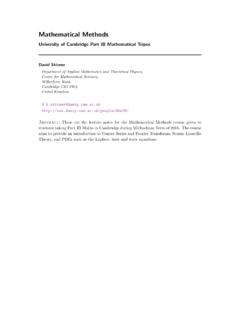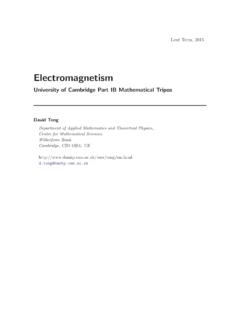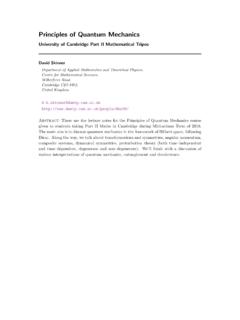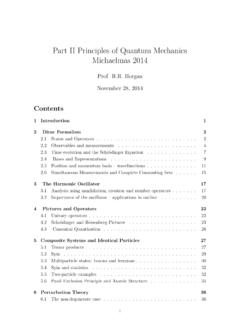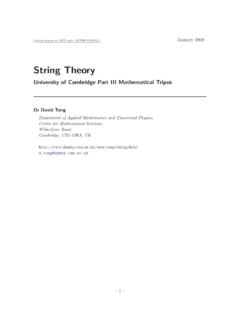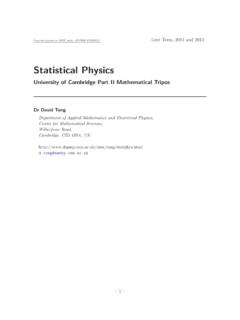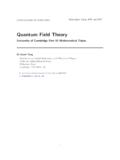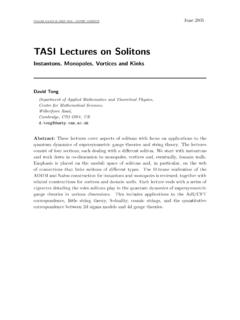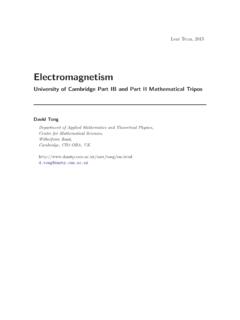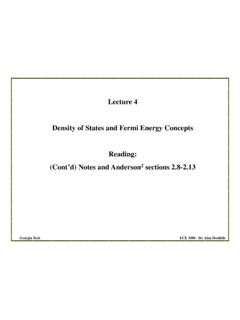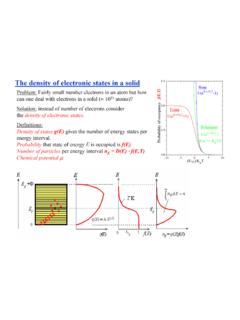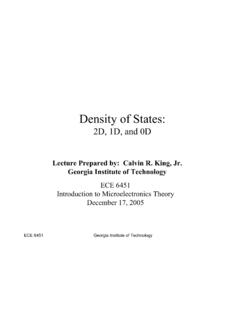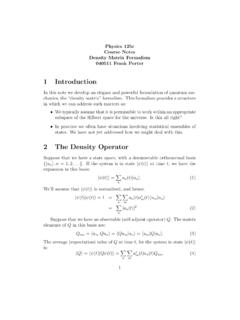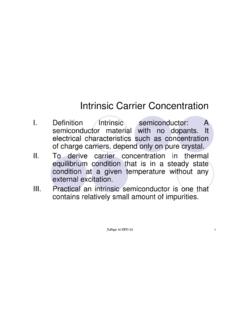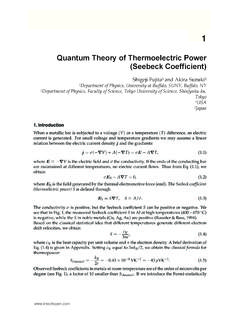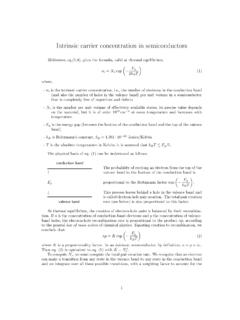Transcription of 3. Quantum Gases - University of Cambridge
1 3. Quantum GasesIn this section we will discuss situations where Quantum e ects are important. We ll stillrestrict attention to Gases meaning a bunch of particles moving around and barelyinteracting but one of the first things we ll see is how versatile the idea of a gascan be in the Quantum world. We ll use it to understand not just the traditional gasesthat we met in the previous section but also light and, ironically, certain properties ofsolids. In the latter part of this section, we will look at what happens to Gases at lowtemperatures where their behaviour is dominated by Quantum density of StatesWe start by introducing the important concept of the density of states . To illustratethis, we ll return once again to the ideal gas trapped in a box with sides of lengthLand volumeV=L3. Viewed Quantum mechanically, each particle is describedby a wavefunction. We ll impose periodic boundary conditions on this wavefunction(although none of the physics that we ll discuss in this course will be sensitive to thechoice of boundary condition).
2 If there are no interactions between particles, the energyeigenstates are simply plane waves, =1pVei~k ~xBoundary conditions require that the wavevector~k=(k1,k2,k3)isquantizedaski=2 niLwithni2 Zand the energy of the particle isE~n=~2k22m=4 2~22mL2(n21+n22+n23)withk=|~k|.Thequantu mmechanicalsingleparticlepartitionfuncti on( )isgivenby the sum over all energy eigenstates,Z1=X~ne E~nThe question is: how do we do the sum? The simplest way is to approximate it by anintegral. Recall from the previous section that the thermal wavelength of the particleis defined to be =s2 ~2mkBT 62 The exponents that appear in the sum are all of the form 2n2/L2,uptosomeconstant factors. For any macroscopic size box, L(a serious understatement!Actually L)whichensuresthattherearemanystateswith E~n kBTall of whichcontribute to the sum. (There will be an exception to this at very low temperatureswhich will be the focus of ).
3 We therefore lose very little by approximatingthe sum by an integral. We can write the measure of this integral asX~n Zd3n=V(2 )3Zd3k=4 V(2 )3Z10dk k2where, in the last equality, we have integrated over the angular directions to get 4 ,thearea of the 2-sphere, leaving an integration over the magnitudek=|~k|and the ,itwillprovemoreusefultochangeintegratio nvariables at this stage. We work instead with the energy,E=~2k22m)dE=~2kmdkWe can now write out integral as4 V(2 )3 Zdk k2=V2 2 ZdEr2mE~2m~2 ZdE g(E)( )whereg(E)=V4 2 2m~2 3/2E1/2( )is thedensity of states :g(E)dEcounts the number of states with energy betweenEandE+dE. Notice that we haven t actually done the integral overEin ( ); insteadthis is to be viewed as a measure which we can integrate over any functionf(E) is nothing particularly Quantum mechanical about the density of states . In-deed, in the derivation above we have replaced the Quantum sum with an integral overmomenta which actually looks rather classical.
4 Nonetheless, as we encounter more andmore di erent types of Gases , we ll see that the density of states appears in all thecalculations and it is a useful quantity to have at our Relativistic SystemsRelativistic particles moving ind=3+1spacetimedimensionshavekineticene rgyE=p~2k2c2+m2c4( ) 63 Repeating the steps above, we find the density of states is given byg(E)=VE2 2~3c3pE2 m2c4( )In particular, for massless particles, the density of states isg(E)=VE22 2~3c3( ) Photons: Blackbody Radiation It was an act of desperation. For six years I had struggled with the black-body theory. I knew the problem was fundamental and I knew the answer. Ihad to find a theoretical explanation at any cost, except for the inviolabilityof the two laws of thermodynamics Max PlanckWe now turn to our first truly Quantum gas: light. We will consider a gas ofphotons the quanta of the electromagnetic field and determine a number of itsproperties, including the distribution of wavelengths.
5 Or, in other words, its we will describe the colour of light at a fixed temperature. But this also applies(with a caveat) to the colour of any object at the same temperature. The argument forthis is as follows: consider bathing the object inside the gas of photons. In equilibrium,the object sits at the same temperature as the photons, emitting as many photons asit absorbs. The colour of the object will therefore mimic that of the surrounding a topic that s all about colour, a gas of photons is usually given a rather blandname blackbody and emission lines due to its particular atomic make-up (this is the caveatmentioned above). We re not interested in these details; we only wish to compute thespectrum of photons that a body emits because it s hot. For this reason, one sometimestalks about an idealised body that absorbs photons of any wavelength and reflects zero temperature, such an object would appear black: this is the blackbody of thetitle.
6 We would like to understand its colour as we turn up the begin, we need some facts about photons. The energy of a photon is determinedby its wavelength or, equivalently, by its frequency!=2 c/ to beE=~!This is a special case of the relativistic energy formula ( )formasslessparticles,m= 0. The frequency is related to the (magnitude of the) wavevector by!=kc. 64 Photons have two polarization states (one for each dimension transverse to the di-rection of propagation). To account for this, the density of states ( )shouldbemultiplied by a factor of two. The number of states available to a single photon withenergy betweenEandE+dEis thereforeg(E)dE=VE2 2~3c3dEEquivalently, the number of states available to a single photon with frequency between!and!+d!isg(E)dE=g(!)d!=V!2 2c3d!( )where we ve indulged in a slight abuse of notation sinceg(!)isnotthesamefunctionasg(E) mistake to make when performing these kinds of manipulations with densities ofstates: you need to remember to rescale the intervaldEtod!
7 Thisismostsimplyachieved by writingg(E)dE=g(!)d!as we have above. If you miss this then you llgetg(!)wrongbyafactorof~.The final fact that we need is important: photons are not conserved. If you putsix atoms in a box then they will still be there when you come back a month isn t true for photons. There s no reason that the walls of the box can t absorbone photon and then emit two. The number of photons in the world is not fixed. Todemonstrate this, you simply need to turn o the photon number is not conserved, we re unable to define a chemical potentialfor photons. Indeed, even in the canonical ensemble we must already sum over stateswith di erent numbers of photons because these are all accessible states . (It issometimes stated that we should work in the grand canonical ensemble at =0whichis basically the same thing). This means that we should consider states with anynumberNof ll start by looking at photons with a definite frequency!
8 AstatewithNsuchphotons has energyE=N~!.SummingoverallNgives us the partition function forphotons at fixed frequency,Z!=1+e ~!+e 2 ~!+..=11 e ~!( )We now need to sum over all possible frequencies. As we ve seen a number of times,independent partition functions multiply, which means that the logs add. We only need 65 Figure 14:The Planck Distribution function (Source: E. Schubert,Light Emitting Diodes).to know how many photon states there are with some frequency!.Butthisiswhatthe density of states ( ) !g(w)logZ!= V 2c3Z10d!!2log 1 e ~! ( ) Planck DistributionFrom the partition function ( )wecancalculateallinterestingquantitiesf oragasoflight. For example, the energy density stored in the photon gas isE= @@ logZ=V~ 2c3Z10d!!3e ~! 1( )However, before we do the integral over frequency, there s some important informationcontained in the integrand itself: it tells us the amount of energy carried by photonswith frequency between!
9 And!+d!E(!)d!=V~ 2c3!3e ~! 1d!( )This is thePlanck distribution. It is plotted above for various temperatures. As youcan see from the graph, for hot Gases the maximum in the distribution occurs at a lowerwavelength or, equivalently, at a higher frequency. We can easily determine where thismaximum occurs by finding the solution todE(!)/d!=0. Itis!max= kBT~where solves 3 =3e .TheequationaboveisoftencalledWien sdisplacement law. Roughly speaking, it tells you the colour of a hot object. 66 To compute the total energy in the gas of photons, we need to do the integrationin ( ). To highlight how the total energy depends on temperature, it is useful toperform the rescalingx= ~!,togetE=V 2c3(kBT)4~3Z10x3dxex 1 The integralI=Rdx x3/(ex 1) is tricky but doable. It turns out to beI= 4/15.(We will e ectively prove this fact later in the course when we consider a more generalclass of integrals ( ) which can be manipulated into the sum ( ).)
10 The net result ofthis is to express the integralIabove in terms of the Gamma function and the Riemannzeta function:I= (4) (4) = 4/15). We learn that the energy densityE=E/Vin agas of photons scales is proportional toT4,E= 2k4B15~3c3T4 Stefan-Boltzmann LawThe expression for the energy density above is closely related to theStefan-Boltzmannlawwhich describes the energy emitted by an object at is defined as the rate of transfer of energy from the surface per unit area. It isgiven byEnergy Flux =Ec4 T4( )where = 2k4B60~3c2= 10 8Js 1m 2K 4is the Stefan factor of the speed of light in the middle equation of ( )appearsbecausethe flux is therateof transfer of energy. The factor of 1/4comesbecausewe renotconsidering the flux emitted by a point source, but rather by an actual object whosesize is bigger than the wavelength of individual photons. This means that the photonare only emitted in one direction: away from the object, not into it.
